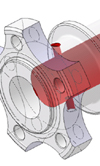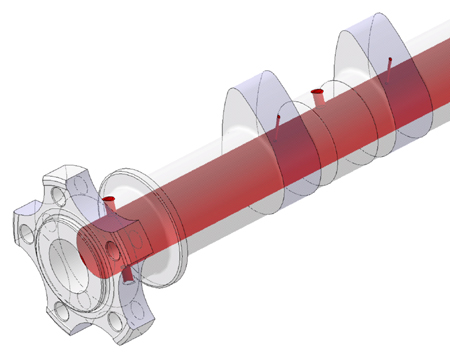Nitrocarburising
 Many of us will be familiar with nitriding as a method of providing a hard wear-resistant surface on some engine components. An additional benefit is that the surface is put into a state of residual compressive stress by treatment. The benefit of doing so are that the fatigue life of the component is extended, even where there is no use made of the wear-resistant nature of the surface.
Many of us will be familiar with nitriding as a method of providing a hard wear-resistant surface on some engine components. An additional benefit is that the surface is put into a state of residual compressive stress by treatment. The benefit of doing so are that the fatigue life of the component is extended, even where there is no use made of the wear-resistant nature of the surface.
One point against nitriding though, in all of its forms, is the amount of time taken to carry out the process. Common gas-nitriding processes can take between 24 and 90 hours, with the less common 'super deep' processes taking more than a week in the furnace. Quite often there isn't the requirement for such deep processes, especially on components with smaller sections.
Nitriding can also result in the very top layers becoming friable and abrasive. For components like crankshafts, where it would compromise the function of the part, a post-nitride grind is necessary. For many parts this would make them very expensive, but they still require some form of hard-wearing treatment or some degree of compressive stress.
Nitrocarburising is a process that is suitable for many of the same materials to which nitriding is applied. In common with the nitriding process, nitrogen is diffused into the surface of the component at temperature. Many nitrocarburising treatments also take place at broadly similar, although generally slightly higher, temperatures to nitriding. However, carbon is also diffused into the surface of the component.
There are variations where other elements are also diffused, sulphur being an example. High concentrations of sulphur are generally frowned upon in the overall composition of steel, as the element forms compounds with other elements - manganese sulphide for example - that can lead to a loss of fatigue strength.
Some metals producers deliberately add sulphur to improve the machinability of certain steels. Sulphur added as a surface diffusion treatment is not likely to cause any damage, and indeed such treatments are known for their damage and seizure resistance in highly loaded sliding contacts .

A number of different nitrocarburising treatments are carried out in salt-bath equipment, where the parts being treated are submerged in baths of molten salts from which the elements diffuse. The active ingredient is a cyanate salt; cyanate ions contain one atom each of oxygen, nitrogen and carbon. Gaseous and plasma nitrocarburising processes are also common. Compounds of these three elements are found in the layer immediately below the surface of the nitrocarburised component; the very top surface layer is a form of iron nitride. Because the surface layers of the part are no longer metallic in nature, the tendency for the part to wear when in sliding contact with metal parts, caused by the mechanism of adhesion, is greatly reduced.
Many processes now also include a post-nitrocarburising oxidation treatment. This converts the very top layer to a form of iron oxide (Fe3O4) which, in addition to being an attractive black colour, also gives improved corrosion resistance. This can be useful for race engines as they are often standing for considerable periods of time immediately after build, or at the end of the season if a strip-down is not required. The oxidation treatment can also contribute to wear resistance.
Fig. 1 - Race camshafts are commonly nitrocarburised (Courtesy of Vitesse Engineering Services)
Written by Wayne Ward